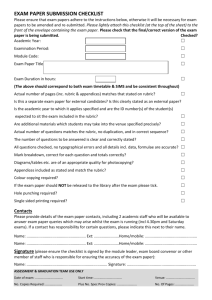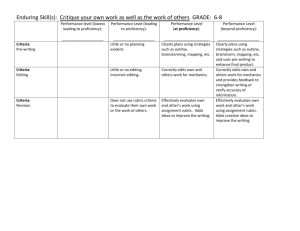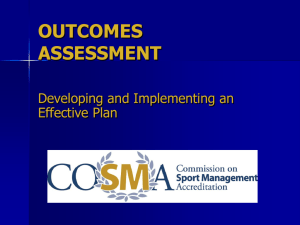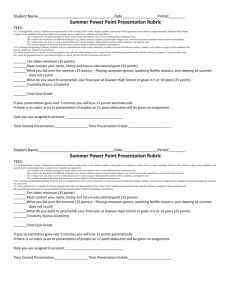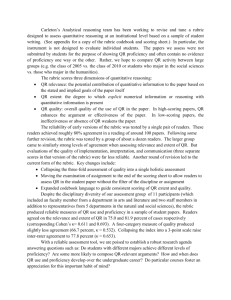Focus on Measurement Tools
advertisement
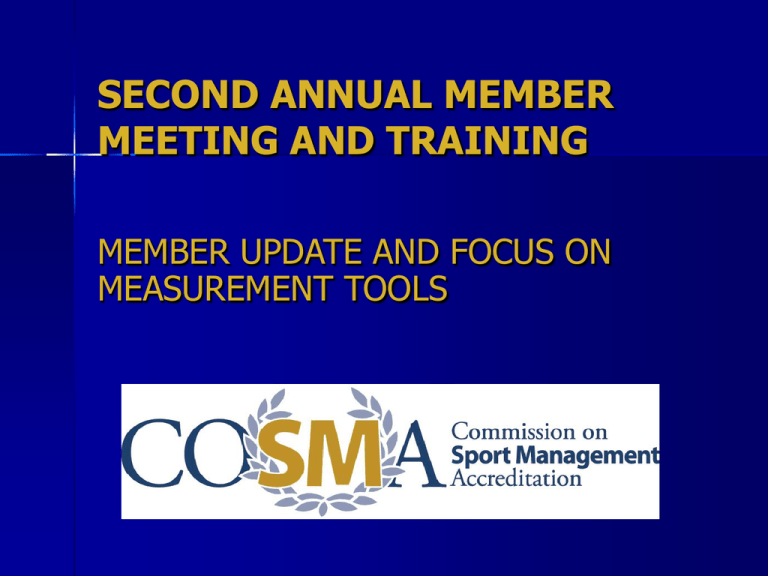
SECOND ANNUAL MEMBER MEETING AND TRAINING MEMBER UPDATE AND FOCUS ON MEASUREMENT TOOLS COSMA Update 40 institutional members 21 individual members 2 accredited institutions 14 institutions have achieved Candidacy Status 5 institutional site visits between October 2010 and May 2011 Training Two full trainings held each year October – AAHPERD headquarters March – AAHPERD Convention Additional training – NASSM Conference Webinar training - TBA Website Payment Option Annual dues and site visit application fee online Safe and secure portal requiring member login Receipt sent to your inbox Take credit card payment only Accreditation Principles Outcomes Assessment Strategic Planning Curriculum Faculty Scholarly & Professional Activities Resources Internal & External Relationships Educational Innovation Principle 1: Outcomes Assessment Five assessment areas – mission and goals, student learning outcome measures, basic skill development, personal development, operational outcomes measures Included in the Self Study: 1. 2. 3. 4. 5. 6. Copy of O/A plan Results of implementation in five assessment areas Summary of changes, improvements needed Summary of action plans to make changes Summary of realized outcomes from action plans Narrative showing integration of O/A results into strategic plan Creating the O/A Plan Mission and broad based goals Student learning outcomes Basic skills development Student personal development Operational outcomes measures Mission and Broad-Based Goals Institution: Provide your institution’s approved mission & broad-based goals Sport Management Program: Provide the approved broad-based goals for your sport management program Measurement: State how you will provide evidence that the goals are being accomplished Student Learning Outcomes What is a learning outcome? Description of what your students are able to do Clear and measurable Related to the goals of the institution Identify measurement tools you will use/rubric design Institutional Goals Program Learning Outcome Communicate effectively both orally and written. Comprehension and application of professional written and oral communication business skills. Measuring Learning Outcomes • Identify a minimum of: • • two direct measures two indirect measures • Explain the process for how your measures will provide meaningful results • Provide copies of your instruments/rubrics in the appendix Direct Measures of Student Learning Demonstrate direct evidence of student learning: • • • • • • • • Comprehensive exams Standardized national exams Pretest and posttest assessments Required structured internship Portfolios (electronic or traditional) Capstone project assessment Thesis/Dissertation External certification program (e.g., NSSE) Indirect Measures of Student Learning Ask students about their learning: • • • • • • • Graduate survey Alumni survey Employer survey Exit interview Advisory Boards Student focus groups Anecdotal evidence Sample Measurement Tools Saint Leo University – Phil Hatlem Dowling College – Marilyn Mather California University of PA – Charles Crowley Troy University – Christina Martin York College of PA – Molly Hayes Sauder Liberty University – Vicky Martin University of North Florida – Jennifer Kane Basic Skills Development Prepare a statement on the “Basic Skills” development program at your institution Describe how this is administered within the SM department Programs to help students with writing deficiencies • Tutoring services • Personal Development of Students Prepare a statement on the “Personal Development” of students at your institution Describe how this is administered within your SM department -- Special programs focused on personal development – interpersonal skills, student leadership -- First year seminar Operational Measures How you will measure effectiveness of your SM program and accomplish goals and objectives outlined in strategic plan: • • • • • • • Graduate and internship placement rates Teaching evaluations Retention rates Graduation rates SWOT analysis Faculty scholarship University-based assessments (okay for program level) Institutional Goals Program Learning Outcome Benchmark Measurement Tool Communicate effectively both orally and written. Comprehension and application of professional written and oral communication skills. 80% of the students will meet defined proficiency standards in writing skills using the writing rubric Written assignments in BU450 evaluated with Rubric 80% of the students will meet defined proficiency standards in presentation skills using the presentation rubric Presentations in BUS 311 evaluated with Rubric Final Step – Action Plans Institutional Goals Student Learning Outcomes Benchmark Measurement Tool Results Action Plan Communicate effectively both orally and written. Comprehension and application of professional written and oral communication business skills. 80% of the students meet proficiency standards in writing measured using writing rubric Written assignments in BU210 and BU404 85.6% of the student in BU210 & BU404 met the standard Continue to record scores for writing evaluation the these two courses. Discuss the possibility of a standardized test in the core courses to meet this competency Problem Areas • Direct measures – linking measure to specific outcome • Rubric development & data collection -- Go beyond using course grades • Role of teaching evaluations Useful Resources for Rubric Development 1. http://course1.winona.edu/shatfield/air/rub rics.htm 2. http://academic.scranton.edu/department/ assessment/ksom/

